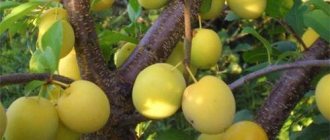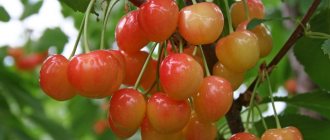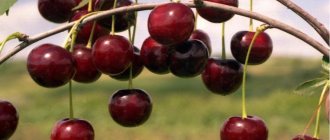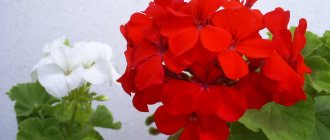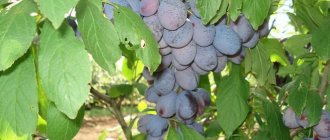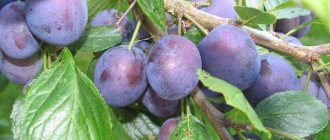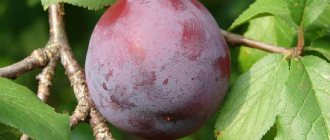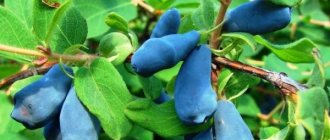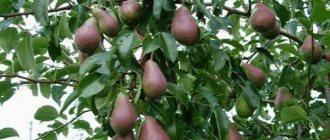Description of the plum variety Manchurian Beauty
The fast-growing Manchurian tree is sometimes classified as a shrub because it lacks a central conductor.
- The height is small, from 1.6 to 1.8–2 m.
- The rounded crown is dense, with brown-gray branches and curved brown shoots.
- On the bark of the Manchurian beauty plum, in addition to peeling, light lenticels are characteristic.
- Another feature of Manchurian plum wood is intensive bud formation, which leads to increased branching.
- Concave, pointed leaves in the shape of an ellipse, medium size, 11 x 4 cm, dark green in color, with a slight sheen.
- The leaf blade, held on an anthocyanin-colored petiole, has carved edges and a central vein that bends slightly downwards.
- Small flowers of the Manchurian beauty plum are formed on bouquet branches. The bud contains up to 3 flowers with white petals that bloom before the leaves.
- Manchurian fruits weigh 15–20 g, sometimes up to 30 g. They are round in shape, with a flattened base, a narrow deep funnel and a slightly pronounced ventral suture.
Plums are firmly attached to short and thick stalks, but only until the full ripening phase. The skin is not very dense, thin, dark burgundy with a bluish tinge. The pointed oblong bone is small and not completely separated from the pulp. The Manchurian beauty plum emits a weak but attractive aroma, the sweet and sour pulp is dense and juicy. The color of the cut fruit is yellow-green.
The invigorating taste of plums is explained by their biochemical composition:
- up to 9 mg of ascorbic acid per 100 g;
- 0.41% tannins;
- from 8 to 15% sugar;
- 17–24% dry matter.
Since the late 40s, the Manchurian Beauty plum variety is also not uncommon in Siberia and the gardens of the Far East. There were attempts to spread the persistent species of Ussuri plum to the European part of the country, but the trees did not feel comfortable and are now quite rare here.
Interesting! This plum is also called the Chuya beauty.
Characteristics of the variety
The largest-fruited among the Ussuri plums, the Manchurian beauty, has its own characteristics.
Drought resistance, frost resistance
An ancient variety, bred on the basis of the most cold-resistant type of plum - Ussuriyskaya, tolerates frosts down to -35...-40 °C. It is not for nothing that many varieties of plums for the Far Eastern and Siberian regions have been created on its basis. The tree can withstand dry periods, but with watering the harvest is better.
Pollinators of plum Manchurian beauty
Many types of Ussuri plums do not bear fruit without pollinators. Over the years of cultivation, the best trees for pollination of the Manchurian tree have been determined:
- Ural golden;
- Ural red;
- Ussuriyskaya;
- Manchurian prunes.
It is advisable to have 2-3 different species in the garden for better cross-pollination and a bountiful harvest.
Manchurian plum blooms early, when there are no leaves on the tree. The date depends on the growing region, but plums are often purchased as a highly decorative spring garden element. The fruits of the Manchurian beauty ripen in late summer - early autumn.
Productivity and fruiting
The variety is early fruiting. Plums are tried three years after planting a one-year-old tree. Productivity is stable in the presence of pollinators. A young plum produces 8–10 kg, an adult plum produces up to 20–24 kg.
Warning! Old variety plums are harvested 3-4 days before they are completely ripe, otherwise they will quickly fall off.
Area of application of berries
The fruits of the Manchurian plum are delicious for consumption as a dessert, as well as in preparations. Compotes, preserves, and jams are made from the berries. The fruits are frozen, so almost all valuable substances are preserved.
Resistance to diseases and pests
Plum is little susceptible to characteristic lesions of the species:
- The Manchurian plum is resistant to a common disease in the Far East - rubella;
- does not succumb to the scourge of plum trees - clasterosporia;
- The beauty is little susceptible to infection with fungi that cause coccomycosis.
But the Manchurian plum is affected by moniliosis. It is necessary to carry out prevention against diseases and pests and adhere to the basic requirements of agricultural technology for garden care in autumn and spring.
Advantages and disadvantages of the variety
Plum has undeniable advantages, thanks to which it has been in demand for a whole century:
- early fruiting;
- stable yield;
- delicious fruits;
- low susceptibility to a number of fungal diseases;
- frost resistance;
- drought resistance.
According to the characteristics of the variety, the Manchurian beauty plum is a valuable breeding material that transmits special characteristics to seedlings.
At the same time, Manchurian plum has its disadvantages:
- self-sterility;
- the need for regular pruning due to the rapid growth of the crown.
storage and harvesting
Fruiting begins 3 years after planting. The average yield of a young tree is 7 kg, of an adult - up to 25 kg. Fruit ripening begins in the last third of August and lasts until mid-September.
It is fundamentally important to harvest within 2-3 days after the fruits reach ripeness, as they are prone to dropping.
With proper care, the Manchurian beautiful woman bears fruit systematically and abundantly
Fresh plums are stored in refrigerators at temperatures from +1 to +5 °C for 7–10 days. For long-term storage, the fruits are dried or frozen.
Plums of this variety tolerate transportation well.
The fruits of Manchurian are beautiful women with a universal purpose. Fresh plums are consumed as a dessert on its own or as a component of it. They are used to prepare liqueurs, sauces, fruit purees, jelly, and marmalade.
The fruits are suitable for: compote, marmalade, jam, confiture.
Plums of this variety make delicious winter preparations.
Planting and caring for the Manchurian beauty plum
The beauty is unpretentious in favorable climatic conditions; you just need to choose the right time and place of planting with loamy or soddy-podzolic soil, close to neutral in acidity.
Recommended timing
Spring is the best time to move plum trees in harsh climates. Autumn planting threatens the freezing of seedlings that have not taken root in a short period.
Choosing a suitable location
Growing Manchurian beauty plum will be successful if the tree is located in a bright, sunny place. The hole is dug on a hill or southern slope, but not in a lowland where cold air stagnates. The seedling is not placed next to a building where there is a lot of snow, because the branches of the Beauty are brittle.
What crops can and cannot be planted nearby?
Plum safely tolerates proximity to apple trees and garden shrubs at a distance of at least 3 m.
- A tall pear tree, especially from the south, reduces the amount of sunlight.
- Also, low plum trees should not be planted near decorative deciduous and coniferous trees.
Important! Plum roots in an area with stagnant water may dry out.
Selection and preparation of planting material
Purchase one-year-old seedlings with fresh, elastic branches and swollen buds. The roots should be fibrous and moist. A few hours before planting, the seedlings are placed in a clay solution.
Landing algorithm
The pit is prepared in advance by laying drainage, adding the necessary substrate and fertilizer.
- A mound is made from the soil in the hole, and a peg is hammered in to support the seedling.
- Place the tree on the mound, straightening the roots.
- The root collar protrudes 4–6 cm above the ground.
- They fill the hole, compact the soil, and make a circular furrow for irrigation.
- Pour 1–1.5 buckets of water and place mulch on the tree trunk circle.
Growing rules
It is best to plant plums in the spring, when the weather is warm. These conditions will help young seedlings take root. When the tree grows, it is necessary to pay special attention to it in the spring - this is the time when spoil appears on the trunk.
The plum ripens early - by the end of August the fruits ripen and begin to fall to the ground. Due to the medium-thick skin, plums do not break on the ground and retain their appearance.
It is especially worth paying attention to the soil and place where the Manchurian beauty is planned to be planted. The soil should be loose, homogeneous and not acidic. The tree should not be planted too close to groundwater on the sunny side of the yard. The plum tree takes root especially well on small mounds, which allows it to capture more sunlight; there will be no accumulation of snow or moisture on the trunk, which causes the root to rot.
You can prune a young tree strictly until it is 3 years old. At a later age, this can lead to death due to gum production. It is not recommended to grow this type of plum alone, because it will not bear fruit. A few more plums should be planted at a distance of up to 3 m. During flowering, the plant cannot be sprayed with anything; it is also better not to water it.
Growing from seed
You can grow a plum by planting a seedling, cuttings, layering, or even a fruit seed. Unlike planting seedlings, stones need to be planted in the fall. Before doing this, it is necessary to carry out simple activities.
- Rinse the seed well and dry in a warm place or in the sun.
- Remove the seed from the shell and add warm water.
- The seeds remaining at the bottom are suitable for sowing.
- Dry the seed, place it in a container with substrate, close tightly and shake.
- Place in the refrigerator for 4-6 months, moistening the soil as necessary during this time.
- Plant in a flower pot with well-moistened soil. Place a layer of expanded clay or charcoal on the bottom of the flowerpot. It is worth immediately accustoming the plant to the soil in which it will grow. To do this, in a 2-3 liter pot you need to put 2 parts of fertilized soil from the garden, part peat and sand.
- Cover the pot with polyethylene and place it on the windowsill on the sunny side of the house.
These measures will help the Manchurian plum germinate faster. After the sprouts appear, they should be cared for in the same way as other house plants. It is not recommended to leave the pot in a draft.
Planting in the soil
The plum should be planted away from other trees, but at a distance of at least 3 m from other types of plums. For the process to be successful, the following sequence must be followed:
- a couple of days before planting, mix the soil from the future hole with humus in a ratio of 1:10, then put it back, leaving room for the seedling;
- the hole for planting the seed should be made deep, 0.6x0.6 m;
- before transplanting, water the soil in the pot and pour it into the hole;
- put hay on top, water-repellent fabric and wrap the crown with burlap.
You can do without planting in a pot and immediately plant plum seeds in the garden in winter, and from April begin to care for it as expected.
To plant a plum seedling, you need to dig a hole 50 cm deep and 70 cm in diameter 2 weeks before planting. After 2 weeks, you can start planting. The seedling must be straightened and covered with soil so that the root collar rises at least 4 cm above the ground.
|| How to propagate golden ball flowers. Rudbeckia, planting and care without hassle. Golden balls flowers: video
Usually they are covered with soil from a hole mixed with humus, sand, potassium chloride, saltpeter, etc. After this, you need to water the plant generously with settled water.
Aftercare for plums
- Manchurian beauty plum seedlings are provided with loosening and watering to the depth of the roots.
- Next spring, a tiered crown begins to form, which is created over the course of 2–3 years.
- Old or damaged shoots are also pruned.
- Feed with NPK complex and organic matter in spring, summer and before winter, mulching the tree trunk circle.
- For the winter, seedlings are protected from rodents with mesh, agrofibre or paper.
Attention! A plum placed on a mound will not suffer from damping off.
Diseases and pests, methods of control and prevention
| Diseases | Symptoms | Treatment | Prevention |
| Moniliosis | The tops are dry, as if burnt, rotten fruits | Treatment with copper-containing preparations | Removing diseased parts, following agricultural practices |
| Gommoz | Gum growths near cracks | Cleaning a wound with garden varnish | Trimming with a clean and sharp tool |
| Pests | Signs | Fighting methods | Prevention |
| Plum moth | Caterpillars spoil young shoots and fruits | Insecticides | Autumn cleaning |
| Plum sawfly | Fruits with larvae | Insecticides | Autumn garden cleaning |
Agricultural technology
Experts recommend planting the Chuya beauty plum in the spring, when the weather outside has already become quite warm. In such conditions, seedlings are more likely to take root and take root. While the young tree is growing, it requires especially close attention. It is at the initial stage of plum cultivation that the risk of prell appearing on the trunk is especially high.
Valerian extract in tablets: benefits and harms, how to take
Particular attention should be paid to the planting site and soil. The soil should be non-acidic, loose and always homogeneous. Under no circumstances should the crop be planted in areas with close groundwater.
Planting plum
The best described type of plum takes root on relatively small slopes, where there is enough sunlight, and moisture and snow will not accumulate on the plant trunk (it is these that in most cases cause rotting of the root system).
You should not spray plants with any useful compounds during the flowering period. At this time, the plum should not even be watered.
You can grow plums in different ways:
- seedlings;
- cuttings;
- layering;
- fruit seeds.
Unlike seedlings, the seed must be planted in the ground in the fall. Before doing this, some simple preparatory measures are required. In particular, the seed must be thoroughly washed and dried well in the sun or on a radiator. Then the seed must be removed from the shell and filled with warm water. The seed is then dried and placed in a container with substrate. A tightly closed container should be stored in the refrigerator for 4 to 6 months, periodically moistening the soil. Then the prepared planting material is planted in a flower pot with moistened soil. A layer of charcoal or expanded clay should be placed at the bottom of the pot.
After planting is completed, the container will remain covered with polyethylene and placed on the windowsill until the sprouts appear. You should care for your sprouts in the same way as you would any other indoor plants.
Plum grown from seed
Planting the Manchurian beauty in the soil should be done away from other trees and no less than three meters from other varieties of plums. For the procedure to be successful, a few days before planting, the soil from the future pit is mixed with humus in a ratio of 1:10 and put back. In this case, it is necessary to leave room for the seedling. The hole will need to be quite large - approximately 0.6 x 0.6 m. When placed in the hole, the seedling must be carefully straightened and covered with earth so that the root collar is at least 4 centimeters above the soil surface. After planting, the plant requires abundant watering with settled water.
Little is known, but insufficiently moist soil can cause the ovaries to fall off and reduce the yield.
In the first winter, the seedling needs mandatory insulation. You can protect the crop from frost using non-woven material or paper. Alternatively, you can burn the fallen leaves and dig up the soil near the trunk. The described manipulations will not only help the plant not to freeze, but will also reduce the risk of rot developing.
To cover a plum tree for the winter, you can burn fallen leaves and dig up the ground near the trunk
An adult plant, cultivated for several years, is fed with nitrogen fertilizers in the spring. They are necessary to accelerate the growth of new shoots and ensure the life of the tree as a whole.
The Manchurian beauty has strong immunity to most diseases and pests. But the crop may well develop a monolithic burn, which can lead to drying out of the affected parts of the tree and rotting of the fruit. In the fight against this problem, a four percent solution of Bordeaux mixture will be an effective remedy.
Pest protection

